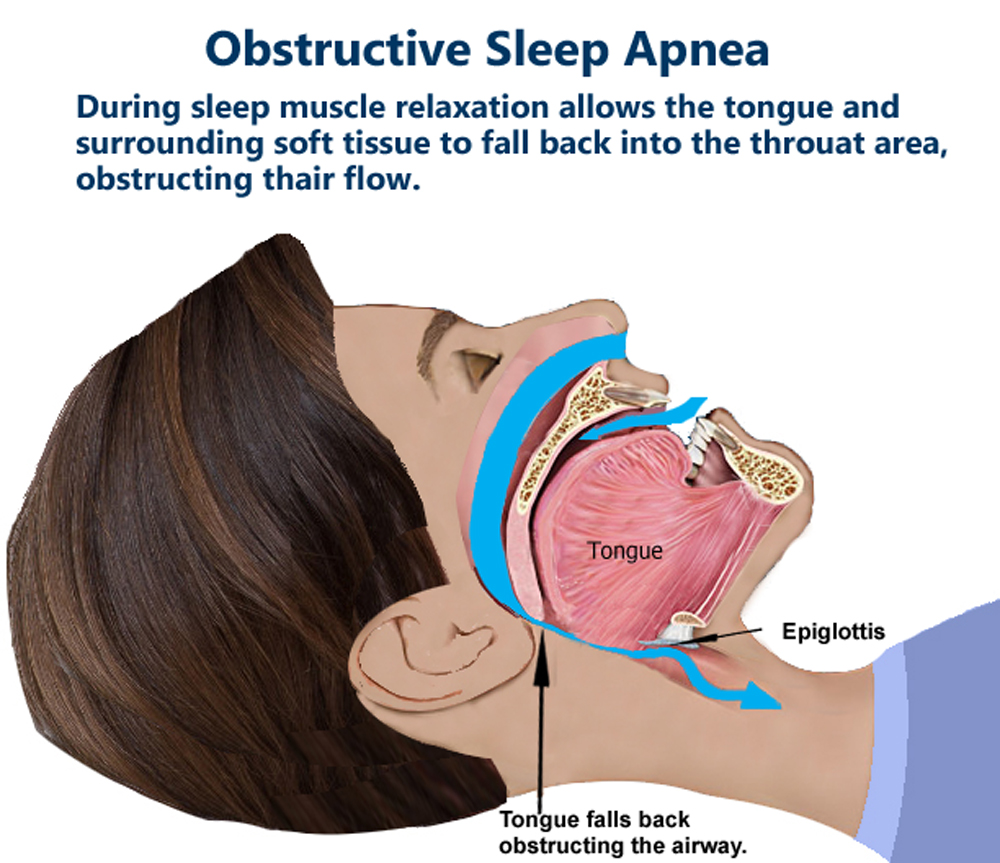Sleep apnea
by Sleep apnea
Posted on 10-09-2021 03:53 am

Sleep apnea - causes, symptoms and treatment
Sleep apnea is a sleep disorder that results in irregular breathing and snoring which eventually causes apnea, in which a person stops breathing for a while. The inability to sleep restfully can lead to extreme fatigue. People can have obstructive sleep apnea, central sleep apnea, or features of both.
Obstructive sleep apnea is the most common type, and it develops when there is a blockage in the airways. Air must pass from the nose through the nasopharynx to the laryngeal pharynx through the larynx and then to the trachea. There may be an obstruction to airflow somewhere along this road. Allergy may cause tissue swelling in the nasopharynx or there may be enlargement of the adenoids or tonsils due to infection. There may be a severe overbite that pushes the jaw back, blocking the airway.
In overweight people, there may be too much weight in the soft tissues of the neck and it may put pressure on the airway, especially when lying down.
These problems become more noticeable at night because hormonal changes at night cause the muscles around the airway to be more relaxed during sleep. This means that they are less able to keep the airway open, making it more likely to become slightly compressed or blocked. Central sleep apnea, on the other hand, indicates that the problem is "central" or related to the central nervous system. Where the brain intermittently stops making the effort to breathe for 10 to 30 seconds , breathing may continue for several seconds even after waking up from sleep, stimulating a feeling of panic and worsening the sleep cycle.
Central sleep apnea begins with an initial episode of hyperventilation, which occurs when the brain directs the lungs to begin hyperventilating during sleep by increasing the rate of breathing. This rapid breathing causes hypochromatosis, i.e., low levels of carbon dioxide in the blood. When carbon dioxide drops below a certain threshold, the body enters a state of apnea, where it stops making the effort to breathe and stops getting oxygen.
This causes carbon dioxide levels to rise to a normal level, and when the apnea continues, it continues to rise to an extent called hypercarbemia. Very high levels of carbon dioxide provoke hyperventilation again, and the cycle begins again . Not making the effort to breathe and the second is hyperventilation, without going through a situation in the middle. The most common symptoms of sleep apnea are severe sleep deprivation. Interrupted sleep may cause nocturia, that is, an intense need to urinate at night, and stress-induced insomnia.
Symptoms are also visible during the day, because the loss of Restful sleep leads to difficulty concentrating, headache and fatigue. Episodes of sleep apnea are usually followed by loud snoring , which can interrupt other people's sleep as well. Sleep apnea alone is rarely fatal, but may worsen other health problems For example, low oxygen levels can provoke angina chest pain, and may irritate the heart cells, causing an arrhythmia.
Sleeping breath has a higher risk of heart failure, respiratory failure, diabetes, and certain types of cancer. Diagnosing sleep apnea requires a polysomnography, to identify episodes of sleep apnea The more episodes the more severe the sleep apnea Typically, sleep monitoring includes monitoring during the night using a polysomnogram The sleep chart tracks things like brain movement, oxygen and carbon dioxide levels, vital signs, and symptoms Phenomenon such as snoring and motion Treating sleep apnea begins with avoiding things like sleeping pills, alcohol, and other depressant medications, because they can relax the throat muscles around the airway and make the airway more susceptible to obstruction during sleep.
In addition, sleeping on the side instead of sleeping on the back can help because it creates better airflow to the lungs. For severe sleep apnea, people can use a continuous positive airway pressure (CPAP) device that keeps the airways open, using a steady stream of compressed air inserted through a plastic face mask or nasal protuberances. This device is very effective when used correctly, but it requires continuous use. Many people eventually stop using it, because they find it annoying or difficult to wear, and thus the problem continues. Some people with obstructive sleep apnea may benefit from specially made mouthpieces that help improve airflow during sleep.
Sometimes obstructive sleep apnea may be treated surgically, for example, by removing the enlarged adenoids or correcting the position of the jawbone, but the operation can be complicated because Both anesthesia and surgery can worsen sleep apnea in the short term As a quick summary, sleep apnea can be caused by a physical obstruction of the airway or a neurological disorder triggered by disturbances in the levels of oxygen and carbon dioxide in the blood, which regulate sleep cycles. If left untreated, the condition can adversely affect other underlying health conditions, causing significant complications.
Resource : https://www.youtube.com/watch?v=cjQPGs_tvDY